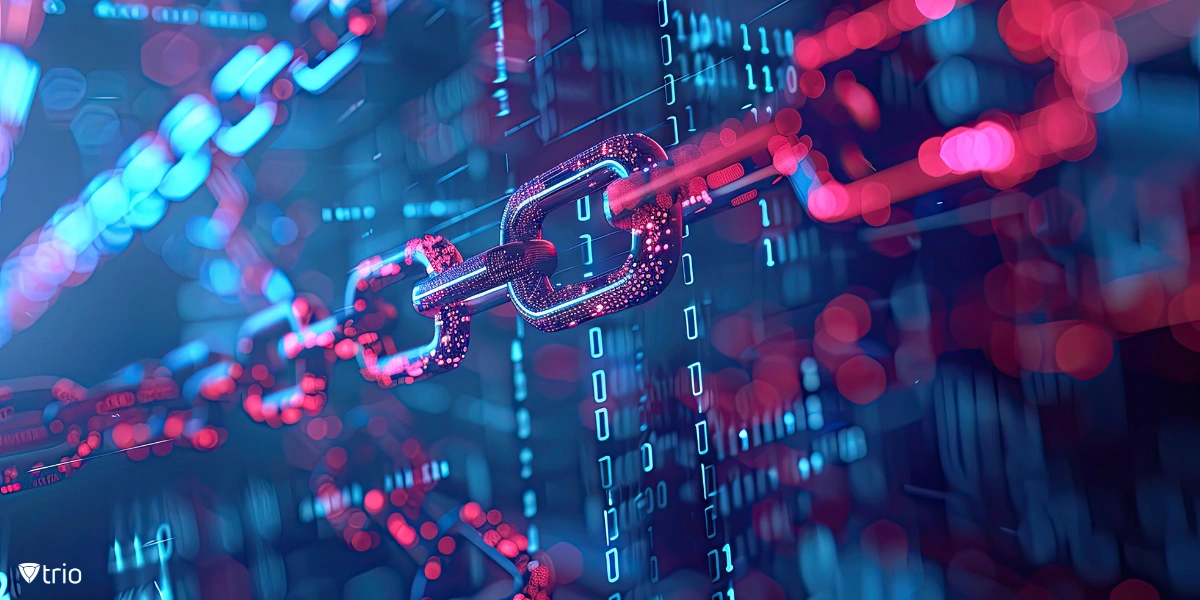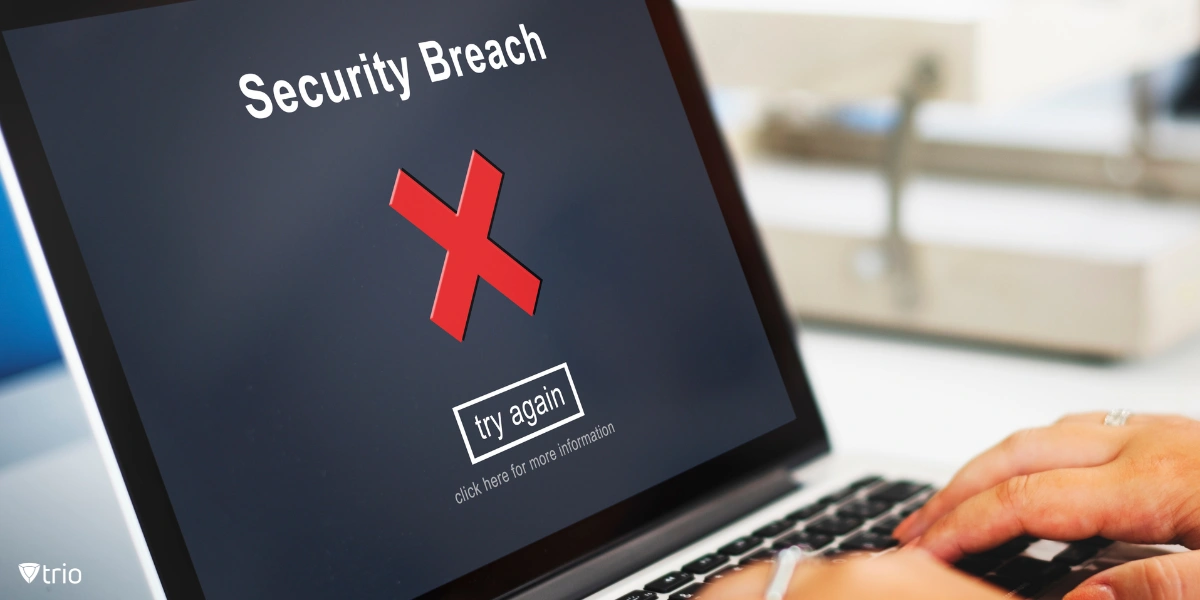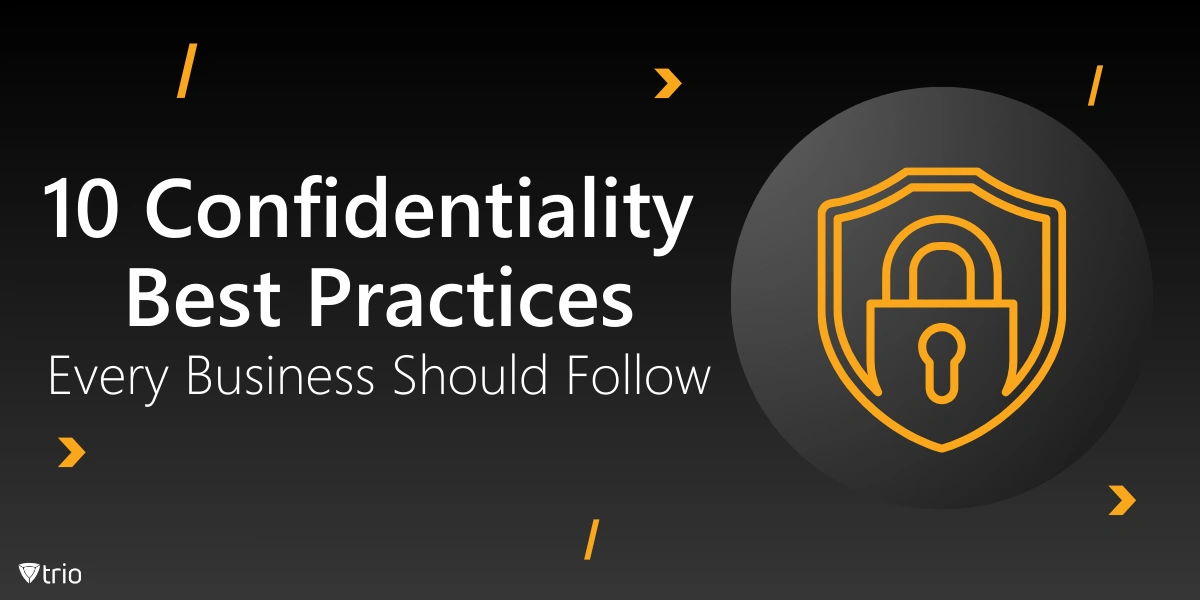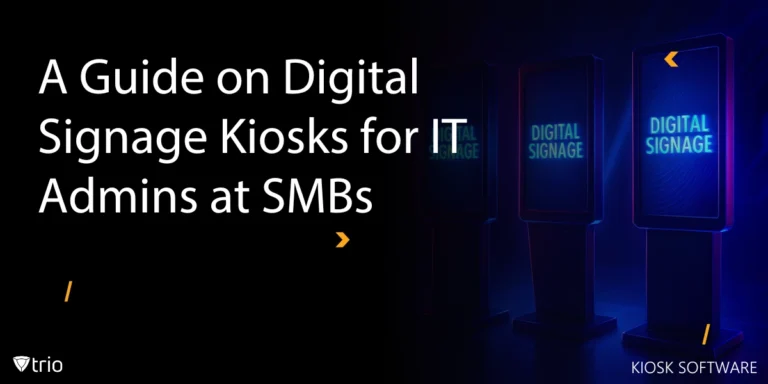Businesses of all sizes grapple with an escalating challenge: How to maintain confidentiality of sensitive information. From customer details and financial records to proprietary trade secrets, the repercussions of a data breach can be catastrophic, eroding consumer trust, inviting legal penalties, and jeopardizing a company's hard-earned reputation. As cybercriminals relentlessly innovate their tactics, it is imperative for organizations to fortify their defenses, implementing robust confidentiality best practices that shield critical assets from prying eyes.
This comprehensive guide delves into ten essential strategies every enterprise should adopt to maintain confidential information and bolster its confidentiality protocols, fostering a culture of vigilance and resilience in the face of ever-evolving cyber threats. We will also offer you numerous confidentiality best practices examples and data confidentiality examples to help you carry out the strategies seamlessly.
1- Cultivate a Culture of Cybersecurity Awareness
The human element is often the weakest link in the cybersecurity chain, underscoring the necessity of cultivating a culture of awareness within your organization. Consistent training and education empower employees to recognize potential threats, equipping them with the knowledge to navigate risks adeptly.
Implement Comprehensive Training Programs
Invest in comprehensive training programs that cover the fundamentals of data protection, including identifying phishing attempts, recognizing social engineering tactics, and adhering to robust password management protocols. Encourage open dialogue, where employees feel empowered to voice concerns or report suspicious activities without fear of reprisal.
Foster a Mindset of Vigilance
Instill a mindset of vigilance by regularly disseminating updates on emerging cyber threats, reinforcing the importance of safeguarding sensitive information. Promote a sense of collective responsibility, where every individual understands their pivotal role in upholding the organization's confidentiality standards.
Simulate Real-World Scenarios
To reinforce learning and gauge preparedness, simulate real-world scenarios such as phishing campaigns or unauthorized access attempts. These immersive exercises not only test employees' ability to identify and respond to threats but also highlight areas requiring further training or policy refinement.
2- Implement Robust Access Controls
Limiting access to confidential data is a fundamental tenet of effective confidentiality management. By implementing robust access controls, organizations can mitigate the risk of unauthorized disclosure or misuse of sensitive information.
Embrace the Principle of Least Privilege
Adhere to the principle of least privilege, granting employees access only to the specific data and resources required for their job functions. Regularly review and update access privileges to ensure they align with evolving roles and responsibilities.
Leverage Multi-Factor Authentication
Enhance security by implementing multi-factor authentication (MFA) for all systems and applications that handle sensitive information. MFA adds an extra layer of protection by requiring multiple forms of verification, such as a password combined with a biometric factor or a one-time code.
Implement Role-Based Access Controls
Adopt a role-based access control (RBAC) model, where permissions are assigned based on an individual's job function or role within the organization. RBAC simplifies access management, reduces the risk of over-privileged accounts, and streamlines the onboarding and offboarding processes.
3- Strengthen Data Encryption Protocols
Data encryption is a powerful tool in the confidentiality arsenal, rendering sensitive information unintelligible to unauthorized parties. By implementing robust encryption protocols, businesses can safeguard their critical assets during transmission and storage.
Encrypt Data at Rest and in Transit
Ensure that all sensitive data, whether at rest (stored on servers or devices) or in transit (being transmitted over networks), is encrypted using industry-standard algorithms and strong encryption keys.
Implement End-to-End Encryption
For added security, consider implementing end-to-end encryption, where data is encrypted on the sender's system and can only be decrypted by the intended recipient, preventing unauthorized access even if the communication channel is compromised.
Manage Encryption Keys Securely
Establish rigorous key management processes, including secure key generation, storage, distribution, and revocation. Regularly rotate encryption keys to mitigate the risk of compromised keys and ensure the ongoing protection of your sensitive data.

4- Fortify Physical and Environmental Security
While digital threats garner significant attention, physical and environmental security measures are equally crucial in safeguarding confidential information. Neglecting these aspects can render even the most robust cybersecurity measures ineffective.
Secure Facilities and Workspaces
Implement access controls for sensitive areas, such as server rooms and document storage facilities. Utilize biometric authentication, surveillance systems, and other physical security measures to prevent unauthorized entry.
Protect Against Environmental Threats
Safeguard your infrastructure against environmental threats like fire, flooding, and power outages. Implement redundant power supplies, backup systems, and disaster recovery plans to ensure the continuity of critical operations and data protection.
Ensure Proper Disposal of Confidential Materials
Establish protocols for the secure disposal of confidential materials, including paper documents, storage media, and decommissioned hardware. Consider implementing secure shredding or degaussing services to prevent the inadvertent disclosure of sensitive information.
5- Strengthen Incident Response and Recovery Capabilities
Despite robust preventive measures, data breaches can still occur. Developing a comprehensive incident response and recovery plan is crucial for minimizing the impact of such events and ensuring business continuity.
Develop a Detailed Incident Response Plan
Craft a detailed incident response plan that outlines specific steps to be taken in the event of a data breach or security incident. Define roles and responsibilities, establish communication protocols, and ensure all stakeholders are familiar with the plan.
Implement Robust Backup and Recovery Strategies
Regularly back up critical data and systems to secure off-site locations or cloud-based storage solutions. Test your recovery procedures periodically to ensure their effectiveness and identify any potential gaps or areas for improvement.
Conduct Regular Incident Simulations
Organize incident simulations to assess the effectiveness of your incident response plan and identify areas for improvement. These exercises not only test your team's readiness but also provide valuable insights into potential vulnerabilities or bottlenecks in your processes.
6- Foster Collaboration and Information Sharing
Effective confidentiality management requires a collaborative approach, both within your organization and across industry sectors. By fostering open communication and information sharing, businesses can stay informed about emerging threats and best practices.
Participate in Industry Forums and Associations
Actively participate in industry forums and associations dedicated to cybersecurity and data protection. These platforms facilitate the exchange of knowledge, lessons learned, and emerging trends, enabling you to stay ahead of potential threats.
Establish Partnerships with Cybersecurity Experts
Cultivate partnerships with cybersecurity experts and consultants who can provide specialized guidance, conduct risk assessments, and offer tailored recommendations to enhance your confidentiality practices.
Encourage Cross-Functional Collaboration
Promote cross-functional collaboration within your organization, bringing together stakeholders from various departments, such as IT, legal, compliance, and risk management. This holistic approach ensures that confidentiality measures are aligned with broader organizational goals and regulatory requirements.
7- Implement Robust Access Monitoring and Auditing
Effective confidentiality management requires continuous monitoring and auditing of access to sensitive information. By implementing robust monitoring and auditing mechanisms, organizations can detect and respond to potential breaches or unauthorized access attempts in a timely manner.
Log and Monitor Access Activities
Implement logging and monitoring systems that capture and analyze access activities related to sensitive data and systems. This includes tracking user logins, file access, and other relevant events, enabling you to identify potential anomalies or suspicious behavior.
Conduct Regular Audits
Regularly conduct audits of access logs, user privileges, and system configurations to ensure compliance with established policies and procedures. Audits can uncover potential vulnerabilities, such as excessive privileges or outdated access controls, allowing you to take corrective action proactively.
Leverage Automated Monitoring Tools
Invest in automated monitoring tools that can analyze access logs and system events in real-time, alerting security teams to potential threats or policy violations. These tools can significantly enhance your ability to detect and respond to incidents promptly, minimizing the potential impact of a breach.

8- Establish Robust Vendor Management Protocols
In today's interconnected business landscape, organizations often rely on third-party vendors and service providers to support various aspects of their operations. However, these partnerships can introduce additional risks if not managed properly, as sensitive data may be shared or accessed by external entities.
Conduct Thorough Vendor Risk Assessments
Before engaging with a new vendor or service provider, conduct thorough risk assessments to evaluate their security posture, data handling practices, and compliance with relevant regulations and industry standards.
Implement Robust Contractual Agreements
Ensure that contractual agreements with vendors and service providers clearly outline confidentiality requirements, data protection obligations, and provisions for auditing and monitoring their adherence to established policies and procedures.
Regularly Review and Monitor Vendor Performance
Establish a process for regularly reviewing and monitoring vendor performance in relation to confidentiality and data protection. Conduct periodic audits, request security reports, and maintain open communication channels to address any concerns or identified risks promptly.
9- Adhere to Regulatory Compliance Standards
Depending on your industry and geographic location, your organization may be subject to various regulatory compliance standards that govern the handling and protection of sensitive information. Failure to adhere to these standards can result in significant legal and financial consequences.
Identify Applicable Regulations and Standards
Conduct a comprehensive assessment to identify all relevant regulations and industry standards that apply to your organization, such as the General Data Protection Regulation (GDPR), the Health Insurance Portability and Accountability Act (HIPAA), or the Payment Card Industry Data Security Standard (PCI DSS).
Implement Compliant Policies and Procedures
Based on the identified regulations and standards, implement compliant policies and procedures that outline specific requirements for data handling, access controls, incident response, and other relevant aspects of confidentiality management.
Maintain Comprehensive Documentation
Maintain comprehensive documentation of your organization's confidentiality policies, procedures, and compliance efforts. This documentation serves as evidence of your commitment to protecting sensitive information and can be invaluable in the event of audits or regulatory inquiries.
10- Leverage Advanced Confidentiality Solutions
While implementing robust policies and procedures is essential, organizations can further enhance their confidentiality practices by leveraging advanced technological solutions specifically designed to safeguard sensitive information.
Implement Data Loss Prevention (DLP) Solutions
Data Loss Prevention (DLP) solutions monitor and control the flow of sensitive data within an organization, preventing unauthorized access, transmission, or loss of confidential information. These solutions can be particularly valuable in preventing accidental or malicious data leaks.
Utilize Encryption and Access Management Tools
Invest in robust encryption and access management tools that provide granular control over who can access specific data sets and ensure that sensitive information is protected both at rest and in transit.
Leverage Managed Detection and Response (MDR) Services
For organizations with limited in-house cybersecurity resources, Managed Detection and Response (MDR) services can provide 24/7 monitoring, threat detection, and incident response capabilities, ensuring that potential confidentiality breaches are promptly identified and mitigated.

Embrace Trio MDM: Your Trusted Confidentiality Partner
Maintaining the confidentiality of sensitive information is a critical challenge for businesses of all sizes. At Trio MDM, we understand the complexities involved in implementing robust confidentiality best practices, and we are dedicated to providing cutting-edge solutions that empower organizations to safeguard their critical assets.
Our comprehensive Mobile Device Management (MDM) platform offers a suite of advanced features designed to enhance data confidentiality and mitigate the risks associated with mobile devices and remote access. With Trio MDM, you can:
- Enforce granular access controls: Implement role-based access controls and multi-factor authentication to ensure that only authorized personnel can access sensitive data on mobile devices.
- Secure data at rest and in transit: Leverage industry-standard encryption protocols to protect sensitive information stored on mobile devices and transmitted over networks.
- Remote device management: Remotely manage and monitor mobile devices, including the ability to locate, lock, or wipe devices in the event of loss or theft, minimizing the risk of data breaches.
- Comprehensive policy enforcement: Define and enforce comprehensive security policies, ensuring consistent adherence to your organization's confidentiality standards across all mobile devices.
- Real-time monitoring and reporting: Gain visibility into mobile device usage, access logs, and potential security incidents through real-time monitoring and reporting capabilities.
Experience the peace of mind that comes with robust confidentiality management. Request a free demo of Trio MDM today and discover how our innovative solutions can fortify your organization's defenses against cyber threats, safeguarding your sensitive information and maintaining the trust of your customers and stakeholders.
Confidentiality Best Practices: Conclusion
Implementing robust confidentiality best practices is crucial for safeguarding sensitive data in today's digital landscape. By cultivating a culture of cybersecurity awareness, implementing strong access controls, leveraging encryption, and fortifying physical security, organizations can significantly reduce the risk of data breaches. Regular training, incident response planning, and adherence to regulatory standards further strengthen these efforts. Collaboration with industry peers and the adoption of advanced technological solutions, such as DLP and MDR services, provide additional layers of protection. Ultimately, the consistent application of these Confidentiality Best Practices not only protects valuable information but also fosters trust, ensures compliance, and safeguards an organization's reputation in an increasingly interconnected world.
Get Ahead of the Curve
Every organization today needs a solution to automate time-consuming tasks and strengthen security.
Without the right tools, manual processes drain resources and leave gaps in protection. Trio MDM is designed to solve this problem, automating key tasks, boosting security, and ensuring compliance with ease.
Don't let inefficiencies hold you back. Learn how Trio MDM can revolutionize your IT operations or request a free trial today!





